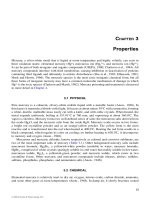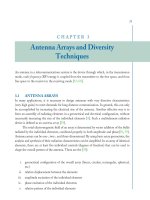Applying career development theory to counseling, 6e chapter 3 and 4
Bạn đang xem bản rút gọn của tài liệu. Xem và tải ngay bản đầy đủ của tài liệu tại đây (77.66 KB, 19 trang )
Chapter 3
NON PSYCHOLOGICAL PERSPECTIVES ON
CAREER DEVELOPMENT
Sociological – Study social organizations rather than
individuals. Studies patterns of customs and interactions of
occupations and other institutions
Economic – Studies the production, distribution, and
consumption of goods and services. Examines
unemployment and pay.
1
COPYRIGHT © 2014 Brooks/Cole*Wadsworth Publishing Company A
division of Cengage Inc.
INEQUITIES IN THE LABOR MARKET
Youth (unemployment and underemployment)
Status Attainment Theory (advantages due to
family status)
The Structure of the Labor Market (limited advancement)
Discrimination
-
Women
-
Culturally diverse populations
COPYRIGHT © 2014 Brooks/Cole*Wadsworth Publishing Company A
division of Cengage Inc.
2
FACTORS CONTRIBUTING TO AN INEQUITABLE LABOR MARKET
Increased demand for lowpaying personal
service occupations
Great separation between
executive and
labor salaries
Limited access to
occupational information
Rapid technological change
COPYRIGHT © 2014 Brooks/Cole*Wadsworth Publishing Company A
division of Cengage Inc.
Lack of loyalty by employers
Racial discrimination
Gender discrimination
Psychiatric hospitalization
Media very accessible
Supply and demand is fickle
Illegal economy - Drugs,
theft
3
YOUTH EMPLOYMENT
Part-time work
Quality of work
Quantity of hours worked
Underemployment
Discrimination against young workers,
especially culturally diverse populations
COPYRIGHT © 2014 Brooks/Cole*Wadsworth Publishing Company A
division of Cengage Inc.
4
SOCIOLOGICAL PERSPECTIVES ON COUNSELING YOUTH
What are attitudes toward work, toward
employers and co-workers?
Examine actual work demands
What are expectations about work: money?
to explore interests? advancement?
What are advantages and disadvantages of
part-time and full time work?
COPYRIGHT © 2014 Brooks/Cole*Wadsworth Publishing Company A
division of Cengage Inc.
5
EFFECT OF THE WORK ON
THE INDIVIDUAL
Work Environment
Person
Tedious
Repetitive
Intellect not required
Work Environment (Substantive Complexity)
Person
Challenging
Exciting
Intellectually stimulating
COPYRIGHT © 2014 Brooks/Cole*Wadsworth Publishing Company A
division of Cengage Inc.
6
HUMAN CAPITAL THEORY
Invest in the individual’s abilities, interests, and values . . .
Education + Training + Work + Other = $
(Relocation, benefits)
(Modified Human Capital Theory)
Education + Training + Work + Other = Satisfaction
(Relocation, benefits)
Assumption: All have equal access to the labor market
COPYRIGHT © 2014 Brooks/Cole*Wadsworth Publishing Company A
division of Cengage Inc.
7
THE STRUCTURE OF THE LABOR MARKET
Primary (core)
Advanced technology, high skills, much training, high wages, job
stability, advancement
Secondary (peripheral)
Low skill, little training, low wages, high turnover, little
advancement
Difficult to move to primary sector
COPYRIGHT © 2014 Brooks/Cole*Wadsworth Publishing Company A
division of Cengage Inc.
8
WOMEN AND DISCRIMINATION IN THE
WORKPLACE
Similar unemployment rates to men, but move in and out of the work
force more frequently than men
Women’s jobs pay less than men’s
Women’s jobs have less prestige than men’s
Gender segregation- difference in distribution of men and women in
various occupations
Men entering more jobs in the service sector previously held by
women
COPYRIGHT © 2014 Brooks/Cole*Wadsworth Publishing Company A
division of Cengage Inc.
9
CULTURALLY DIVERSE INDIVIDUALS AND
DISCRIMINATION IN THE WORK PLACE
Unemployment rate for African American and Latinos is greater
than the rates for Asians and Caucasians
Relatively few Latinos and African Americans in high skill jobs
African American men have higher unemployment rates because of
fewer opportunities for less educated workers
When African Americans and Caucasians have similar resumés,
African American men, at all education levels, experience
discrimination
African Americans are involuntary minorities who have different
attitudes towards work than voluntary minorities (Ogbu)
COPYRIGHT © 2014 Brooks/Cole*Wadsworth Publishing Company A
division of Cengage Inc.
10
Chapter 4
WORK ADJUSTMENT THEORY
Step 1:
Gaining self-understanding
Abilities - Encompass aptitudes (predicted skills) and acquired
skills
General Aptitude Test Battery
General learning
Verbal ability
Numerical ability
Spatial ability
Form perception
Clerical ability
Eye-hand coordination Finger dexterity
Manual dexterity
COPYRIGHT © 2014 Brooks/Cole*Wadsworth Publishing Company A
division of Cengage Inc.
Interests - Derived from values and abilities
11
WORK ADJUSTMENT THEORY:
VALUES AND NEEDS
Achievement
Status
Ability utilization Advancement
Achievement
Recognition
Authority
Social Status
Safety
Company policies
and practices
Supervision human relations
Supervision technical
Comfort
Altruism
Autonomy
Activity
Co-workers
Creativity
Independence
Moral values
Responsibility
COPYRIGHT © 2014 Brooks/Cole*Wadsworth Publishing Company A
division of Cengage Inc.
Variety
Social Services
12
PERSONALITY STYLES
(How Abilities and Values Interact with a Work Situation)
Celerity – Speed in doing task
Pace – Effort spent in working
Rhythm – Pattern of one’s pace or effort
Endurance – How likely one is to stay working on a task
COPYRIGHT © 2014 Brooks/Cole*Wadsworth Publishing Company A
division of Cengage Inc.
13
WORK ADJUSTMENT THEORY
Step 2:
Obtaining Knowledge about the World of Work
Ability Patterns - Abilities that are important to an occupation as determined
by job analysts and GATB scores.
Verbal ability
Form perception
Numerical ability Clerical ability
Spatial ability
Finger dexterity
Manual dexterity
Eye-hand coordination
Value Patterns - values that are reinforced by an occupation as determined by
patterns of responses to the Minnesota Job Description Questionnaire.
COPYRIGHT © 2014 Brooks/Cole*Wadsworth Publishing Company A
division of Cengage Inc.
Achievement
Status
Safety
14
WORK ADJUSTMENT THEORY
Step 3:
Integrating Information about Self and the World of Work
The Minnesota Occupational Classification System matches
Abilities
General Aptitude Test Battery
Ability Pattern
Values
Minnesota Importance Questionnaire Values Pattern
Personality
COPYRIGHT © 2014 Brooks/Cole*Wadsworth Publishing Company A
division of Cengage Inc.
15
The following factors describe a person’s adjustment to an occupation:
flexibility, activeness, reactiveness, and perseverance.
QUALITIES DESCRIBING FIT BETWEEN
ABILITIES, VALUES, AND WORK
Flexibility – Ability to tolerate unpleasant or difficult aspects
of a job
Activeness – Trying to change one’s environment
Reactiveness – Changing oneself in a work environment
Perseverance – How long one can tolerate bad conditions
before changing jobs
COPYRIGHT © 2014 Brooks/Cole*Wadsworth Publishing Company A
division of Cengage Inc.
16
ADAPTIVE PERFORMANCE
(Satisfaction and Well Being While Dealing with Change)
Proactive behavior
Reactive behavior
Tolerant behavior
(Griffin & Hesketh, 2005)
COPYRIGHT © 2014 Brooks/Cole*Wadsworth Publishing Company A
division of Cengage Inc.
17
WORK ADJUSTMENT THEORY
ASSESSMENT INSTRUMENTS
Minnesota Importance Questionnaire
Minnesota Job Description Questionnaire
Minnesota Satisfaction Questionnaire
Minnesota Satisfactoriness Scales
COPYRIGHT © 2014 Brooks/Cole*Wadsworth Publishing Company A
division of Cengage Inc.
18
Satisfaction
Satisfactoriness









